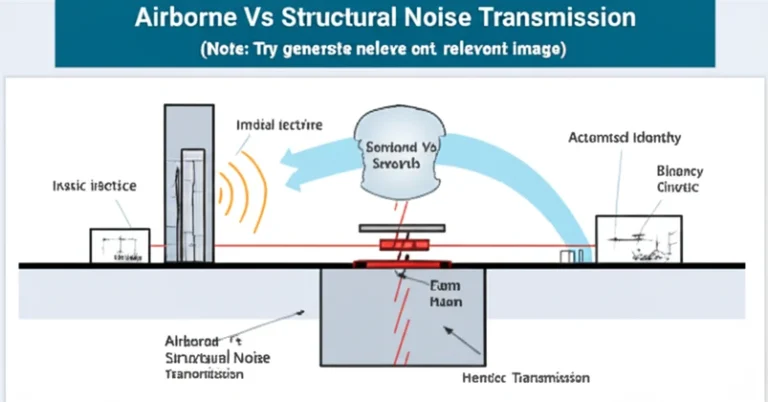
The relentless cacophony of urban life, from the constant hum of traffic to the clang of construction, presents a significant challenge to public health and well-being. This article delves into how acoustic barriers effectively combat noise pollution in urban environments, exploring their diverse types, applications, innovative designs, and the science behind their effectiveness. By understanding the principles and practicalities of noise reduction, we can create more livable and harmonious urban spaces.
City life offers numerous advantages, but the pervasive noise pollution isn’t one of them.
From bustling traffic and construction sites to industrial zones and crowded public spaces, urban noise significantly impacts public health and quality of life. This article addresses the crucial question: how do acoustic barriers reduce noise pollution in urban environments? We’ll explore the growing problem of urban noise, the science behind acoustic barriers, their various types and applications, and the latest innovations in noise control technology.
The Growing Problem of Urban Noise Pollution
Health and Environmental Impact
Noise pollution isn’t merely an annoyance; it’s a serious public health concern, impacting millions worldwide.
Studies by the World Health Organization have linked prolonged exposure to high noise levels (above 70 dB) to a range of adverse health effects, including stress, sleep disturbances, cardiovascular issues, cognitive impairment, and reduced productivity. Children are particularly vulnerable, with noise pollution affecting their learning and development. Furthermore, excessive noise disrupts urban ecosystems, altering wildlife behavior, communication patterns, and even habitat selection.
Sources of Urban Noise
Several key sources contribute to the urban noise landscape:
- Transportation: The dominant source in most cities, encompassing road traffic, railways, airports, and shipping.
- Industrial Activities: Factories, construction sites, power plants, and loading docks generate substantial noise.
- Urban Development: Densely populated areas, mixed-use developments, entertainment venues, and crowded public spaces amplify noise levels.
- Human Activity: Concerts, sporting events, public announcements, and even neighborhood noise contribute to the overall soundscape.
Acoustic barriers strategically target these noise sources, mitigating their impact and creating healthier urban environments.
How Acoustic Barriers Work
Acoustic barriers reduce noise pollution by manipulating the path of sound waves.
They achieve this through three primary mechanisms: blocking, absorbing, and deflecting.
Mechanisms of Noise Reduction
- Blocking: Solid, dense materials create a physical obstruction that prevents sound waves from directly reaching the receiver. This is particularly effective for low-frequency noise.
- Absorption: Porous materials like fiberglass, mineral wool, or specialized acoustic foams convert sound energy into heat through friction, reducing the overall noise level. The effectiveness of absorption depends on the material’s properties and the frequency of the sound.
- Deflection: Carefully angled surfaces redirect sound waves upwards or away from sensitive areas, minimizing their impact.
This is particularly useful for mitigating noise from highways and railways.
The effectiveness of an acoustic barrier is determined by several factors, including its height, material composition, surface density, placement relative to the noise source and receiver, and the surrounding topography. A comprehensive understanding of these factors is essential for optimal noise reduction.
Types of Acoustic Barriers
Acoustic barriers can be broadly categorized as natural or artificial, each with its own set of advantages and disadvantages.
Natural Barriers
Natural barriers utilize existing landscape features or vegetation to mitigate noise:
- Earth Berms: Mounds of earth covered with vegetation effectively absorb and deflect sound waves, integrating seamlessly with the environment.
- Tree Belts and Green Walls: Densely planted trees and shrubs can provide a degree of noise reduction, particularly for higher frequencies. Green walls, which incorporate vegetation on vertical structures, offer both aesthetic and acoustic benefits.
Artificial Barriers
Artificial barriers are engineered structures designed specifically for noise control:
- Concrete Walls: Highly effective for blocking low-frequency noise due to their density and mass.
- Metal Barriers: Durable and often used in industrial settings, they can be designed with perforations or absorbent materials to enhance their performance.
- Polycarbonate Panels: Lightweight and transparent, they provide noise reduction while maintaining visibility and aesthetics.
- Wood Barriers: While less effective than concrete or metal, wood barriers can be aesthetically pleasing and suitable for specific applications.
- Composite Panels: Combining different materials, composite panels can offer optimized noise reduction and weather resistance.
Applications of Acoustic Barriers in Urban Settings
Transportation Corridors
Acoustic barriers are extensively used along highways and railways to protect nearby communities from traffic noise.
For example, the installation of noise barriers along a major highway in Los Angeles resulted in a 10-15 dB reduction in noise levels for adjacent residential areas.
Residential Areas
Acoustic fences and walls provide tranquility in residential neighborhoods, shielding homes from traffic, construction, or neighborhood noise. A case study in London showed that strategically placed barriers around a residential complex reduced noise levels by 8 dB, significantly improving residents’ sleep quality.
Public Spaces
Parks, schools, and recreational areas benefit from acoustic barriers, creating peaceful environments for relaxation and play. The use of earth berms and vegetation in a New York City park reduced traffic noise intrusion, enhancing the visitor experience.
Innovative Designs and Technologies
Green Acoustic Walls
Green walls integrate vegetation with sound-absorbing materials, combining noise reduction with ecological benefits like improved air quality and biodiversity.
These living walls can be incorporated into buildings and other structures.
Modular Barriers
Modular acoustic barrier systems offer flexibility and adaptability, making them ideal for temporary construction sites or projects with evolving needs. They can be easily assembled, disassembled, and relocated.
Smart Barriers
Smart barriers incorporate sensors and AI to monitor noise levels in real time, adjusting their configurations dynamically for optimal performance. They can also integrate with other smart city systems for comprehensive noise management.
FAQ
What materials are used for acoustic barriers?
Acoustic barriers utilize a variety of materials, including concrete, metal, wood, polycarbonate, and composite panels, each with its own acoustic properties and suitability for different applications.
Material selection depends on factors like desired noise reduction, budget, aesthetics, and environmental considerations.
Can acoustic barriers eliminate noise completely?
While acoustic barriers can significantly reduce noise pollution, complete elimination is generally not achievable. The level of noise reduction depends on the barrier’s design, materials, placement, and the characteristics of the noise source. Well-designed barriers can typically achieve a reduction of 10-15 dB, which can significantly improve the acoustic environment.
How do natural barriers compare to artificial ones?
Natural barriers offer aesthetic and environmental benefits but are generally less effective than engineered artificial barriers, especially for high-frequency noise.
Natural barriers are best suited for situations where complete noise blockage isn’t required and where integration with the surrounding environment is a priority.
Are acoustic barriers cost-effective?
The cost-effectiveness of acoustic barriers depends on factors like the scale of the project, materials used, and the long-term benefits achieved. While the initial investment can be significant, the benefits of reduced noise pollution, improved public health, increased property values, and compliance with noise regulations often outweigh the costs.
Conclusion
Acoustic barriers are a crucial tool for mitigating noise pollution and improving the quality of life in urban environments. From reducing traffic noise along busy highways to creating tranquil spaces in residential areas and public parks, these structures play a vital role in fostering healthier and more livable cities.
By embracing innovative designs and technologies, we can continue to refine and optimize noise control strategies, creating urban soundscapes that promote well-being and harmony. If you are facing noise pollution challenges, consulting with acoustic experts can help you determine the most effective solutions for your specific needs. More information on urban noise mitigation strategies in city planning can be found here.






